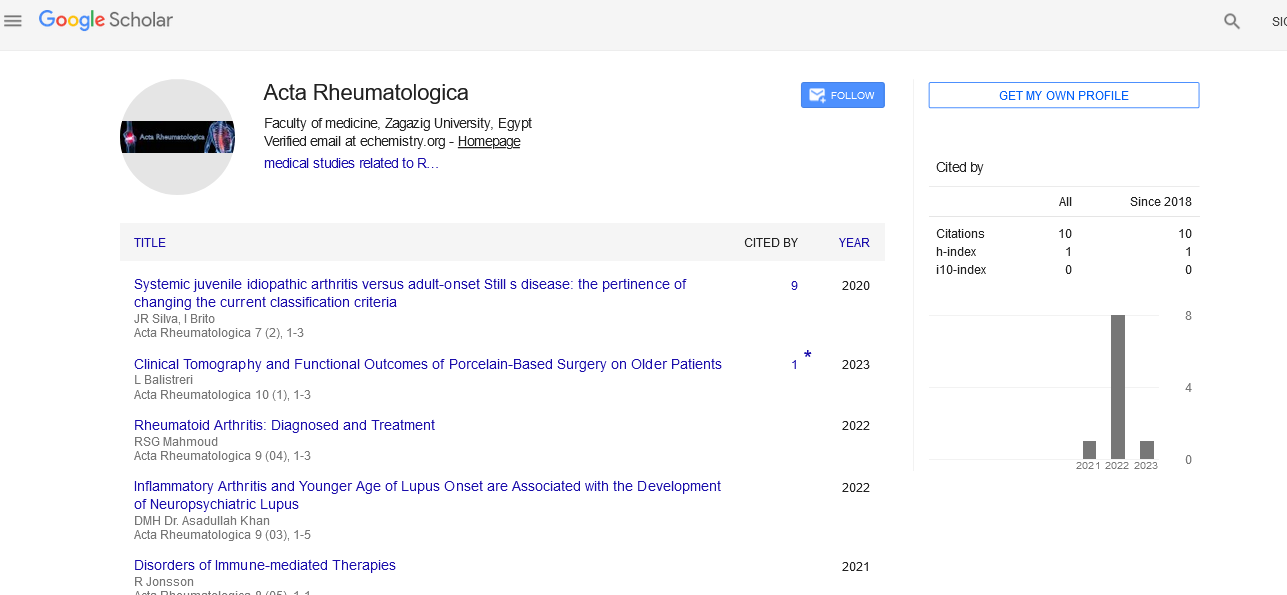Perspective - (2024) Volume 11, Issue 4
Understanding Sjogren's Syndrome: Navigating the Challenges of a Complex Autoimmune Disorder
Ruitao Yu*
Department of Health Care, University of Munich, Munchen, Germany
*Correspondence:
Ruitao Yu, Department of Health Care, University of Munich, Munchen,
Germany,
Email:
Received: 11-Jul-2024, Manuscript No. IPAR-24-15054;
Editor assigned: 15-Jul-2024, Pre QC No. IPAR-24-15054 (PQ);
Reviewed: 29-Jul-2024, QC No. IPAR-24-15054;
Revised: 07-Aug-2024, Manuscript No. IPAR-24-15054 (R);
Published:
16-Aug-2024
Introduction
Sjogren's syndrome is a chronic autoimmune disease
characterized by dryness of the eyes and mouth, as well as
systemic manifestations that can affect various organs and
tissues in the body. Named after Dr. Henrik Sjögren, who first
identified the condition in the early 20th century, Sjögren's
syndrome presents unique challenges due to its diverse
symptoms and varying degrees of severity. In this article, we
explore the intricacies of Sjögren's syndrome, including its
causes, symptoms, diagnosis, treatment options, and the
ongoing research efforts aimed at improving understanding and
management of this often misunderstood disease.
Description
Understanding sjögren's syndrome
Sjögren's syndrome is primarily characterized by two main
symptoms: dry eyes (keratoconjunctivitis sicca) and dry mouth
(xerostomia). These symptoms occur due to inflammation that
targets the body's moisture-producing glands, including the tear
and saliva glands. In addition to affecting the eyes and mouth,
Sjögren's syndrome can also cause systemic manifestations,
affecting organs such as the skin, lungs, kidneys, and nervous
system.
Causes and risk factors
The exact cause of Sjögren's syndrome remains unclear, but it
is believed to involve a combination of genetic predisposition
and environmental triggers. Autoimmune diseases occur when
the immune system mistakenly attacks healthy tissues, and in
Sjögren's syndrome, this immune dysfunction primarily targets
the glands responsible for producing tears and saliva.
Environmental factors such as viral infections may trigger or
exacerbate the immune response in genetically susceptible
individuals.
Women are disproportionately affected by Sjögren's
syndrome, with the majority of cases diagnosed in women aged
40 to 60. However, men and individuals of any age can also
develop the condition.
Symptoms of sjögren's syndrome
The symptoms of Sjögren's syndrome can vary widely among
individuals and may include:
Dry eyes: Persistent dryness, burning, or a gritty sensation in
the eyes, sensitivity to light, and blurred vision.
Dry mouth: Difficulty swallowing, altered taste sensation,
mouth sores, increased dental decay, and oral infections.
Systemic symptoms: Fatigue, joint pain and stiffness, skin
rashes, chronic cough, shortness of breath, and neurological
symptoms such as numbness or tingling in the hands and feet.
Organ involvement: Inflammation of the kidneys (nephritis),
lungs (interstitial lung disease), liver (hepatitis), and nervous
system (neuropathy).
The severity of symptoms can fluctuate over time, with
periods of exacerbation (flares) and remission.
Diagnosis
Diagnosing Sjögren's syndrome can be challenging due to its
wide-ranging symptoms and overlap with other autoimmune
conditions. A comprehensive evaluation by a rheumatologist or
other healthcare provider typically includes:
Medical history and physical examination: Inquiring about
symptoms such as dry eyes, dry mouth, and systemic
complaints.
Blood tests: Testing for specific autoantibodies associated
with Sjögren's syndrome, such as anti-SSA (Ro) and anti-SSB (La)
antibodies, as well as markers of inflammation.
Eye and mouth evaluation: Assessing tear production using
Schirmer's test and evaluating saliva flow.
Imaging studies: Occasionally, imaging tests such as
ultrasound or MRI may be used to assess glandular involvement.
In some cases, a minor salivary gland biopsy may be
performed to evaluate for characteristic changes seen in
Sjögren's syndrome.
Treatment options
Currently, there is no cure for Sjögren's syndrome, so
treatment focuses on managing symptoms, preventing
complications, and improving quality of life. Treatment
strategies may include:
Artificial tears and lubricating eye drops: To relieve dryness
and protect the eyes.
Saliva substitutes and prescription medications: To alleviate
dry mouth symptoms and promote oral health.
Medications: Nonsteroidal Anti-Inflammatory Drugs (NSAIDs)
for joint pain, hydroxychloroquine for systemic symptoms, and
immunosuppressants (such as methotrexate or corticosteroids)
for more severe cases.
Moisture conservation techniques: Using humidifiers to add
moisture to the air and avoiding dry, windy environments.
Regular follow-up visits with healthcare providers, including
ophthalmologists, dentists, and rheumatologists, are important
to monitor disease progression, manage medications, and
address emerging symptoms or complications.
Living with sjögren's syndrome
Coping with Sjögren's syndrome involves adapting to the
chronic nature of the disease and implementing strategies to
manage symptoms effectively. Lifestyle modifications and
supportive measures can play a significant role in enhancing
quality of life:
Oral hygiene: Maintaining good oral hygiene practices,
including regular dental visits and fluoride treatments, to
prevent dental decay and infections.
Eye care: Protecting the eyes from irritation and injury, using
sunglasses outdoors, and avoiding prolonged screen time to
minimize eye strain.
Nutrition: Consuming a balanced diet rich in omega-3 fatty
acids, antioxidants, and staying hydrated to support overall
health.
Physical activity: Engaging in regular, low-impact exercise to
maintain joint flexibility, muscle strength, and overall well-being.
Emotional support: Seeking support from family, friends, and
support groups to cope with the emotional and psychological
aspects of living with a chronic illness.
Research and future directions
Advancements in research are crucial for improving
understanding of Sjögren's syndrome and developing targeted
therapies. Current research focuses on identifying biomarkers
for early diagnosis, exploring the role of genetic factors and
environmental triggers, and investigating novel treatment
approaches to reduce inflammation and preserve glandular
function.
Clinical trials and collaborative efforts among researchers,
healthcare providers, and patient advocacy groups are essential
for advancing knowledge and improving outcomes for
individuals living with Sjögren's syndrome.
Conclusion
Sjögren's syndrome is a complex autoimmune disease that
requires a multidisciplinary approach to management. By raising
awareness, promoting research, and providing comprehensive
support, we can empower individuals affected by Sjögren's
syndrome to effectively manage their symptoms and enhance
their quality of life. Continued advocacy, education, and
innovation are essential in striving towards improved diagnosis,
treatment, and ultimately, finding a cure for this challenging
autoimmune condition.
Citation: Ruitao Yu (2024) Understanding Sjogren's Syndrome: Navigating the Challenges of a Complex Autoimmune Disorder. Acta Rheuma Vol:11 No:4





